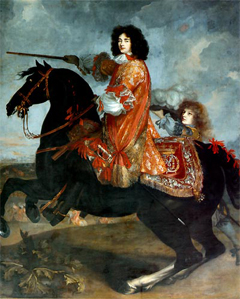Monmouth
From the Quicksilver Metaweb.
This is an intermediate page for James Scott, 1st Duke of Monmouth.
Stephensonia
Monmouth sets a lot of pieces in motion
Authored entries
- Stephenson:Neal:Quicksilver:246:Apthorp---the second A (Neal Stephenson)
- Battle of Sedgemoor (Cheryl Morgan)
- Judge Jeffreys (Alan Sinder)
Community entry
James, Duke of Monmouth was the bastard son of Charles II by his mistress, Lucy Walter. Monmouth was born in Amsterdam and raised a Protestant. When Charles was invited back to England young James was brought to join him and named Duke of Monmouth, but he was not recognised as a legitimate heir. Monmouth was forced to flee England in 1683 after being implicated in a plot to kill the king. When James II, a devout Catholic, became king Monmouth became a champion of the Protestant cause and launched an invasion. However, his effort was poorly planned and funded, obtained little support from the nobility, and came to grief at the Battle of Sedgemoor.
Duke of Monmouth
James Scott, 1st Duke of Monmouth
From Wikipedia, the free encyclopedia.
James Crofts, later Scott, 1st Duke of Monmouth, 1st Duke of Buccleuch (April 9, 1649 -July 15, 1685 ) recognized by some as James II of England and James VII of Scotland, was born in Amsterdam in the Netherlands, the son of Charles II and his mistress, Lucy Walter, who had followed him into continental exile after the execution of King Charles I.
Lucy Walter had almost as bad a reputation as the prince himself, and it is not at all certain that Charles was the natural father. There was also a rumour of their having been secretly married, which would have made James the true and legitimate heir to the throne. Whatever the truth, Charles recognised James as his son, but did not make him his heir. After acceding to the throne, he married the Portuguese princess, Catherine of Braganza ; by this time Lucy Walter was dead. In 1663, shortly after having been brought to England, James was created Duke of Monmouth and married off to the wealthy Anne, Countess of Buccleuch. Although he showed no aptitude for government, James was popular, particularly since he was a Protestant, whereas the official heir to the throne, James, Duke of York, was a Catholic.
At the age of 16 Monmouth served in the fleet under his uncle the Duke of York in the Second Anglo-Dutch War. Later in the war, he returned to England to assume his first military command as commander of a troop of cavalry. In 1669 he was made colonel of the king's Life Guards, one of the most senior appointments in the army. When the Captain General of the army, Lord George Monck, died in 1670, Monmouth became the senior officer in the army at the age of 21. At the outbreak of the Third Anglo-Dutch War in 1672, a brigade of 6,000 British troops was sent to serve as part of the French army (in return for money paid to King Charles), with Monmouth as its commander. In the campaign of 1673 and in particular at the siege of Maastricht, Monmouth gained a considerable reputation as one of England's finest soldiers.
In 1678 Monmouth was commander of the Anglo-Dutch brigade, now fighting for the United Provinces against the French. He distinguished himself at the battle of St Denis, further increasing his reputation. The following year, after his return to England, he commanded the small army raised to put down the rebellion of the Scottish Covenanters. Despite being heavily outnumbered, he decisively defeated the rebels at the Battle of Bothwell Bridge on June 22, 1679. By this time it was becoming apparent that Charles II would have no legitimate heir, and Monmouth was regarded by many as preferable to the Duke of York.
Following the discovery of the so-called Rye House Plot in 1683, Monmouth was obliged to go into exile in the Dutch United Provinces. He returned on his father's death in an attempt to take the throne from his uncle. He declared himself King on June 20, 1685 at Bridgwater. On July 6, 1685 the two armies met at the Battle of Sedgemoor, the second last to be fought on English soil. Monmouth's makeshift force could not compete with the regular army, and was soundly defeated. Monmouth himself was captured and arrested. Despite begging for mercy, he was executed on July 15, 1685, on Tower Hill. It is said that it took eight blows of the axe to sever his head.